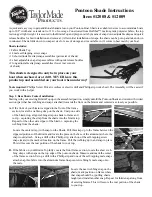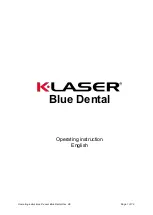
Page 16
Chapter 3 Configuration
BD500 Broadcast Profanity Delay
©Eventide Inc. 1995-1999
doc release 10
OSC
Oscillator (or Oscillator and Pause)
This parameter controls the technique used to per-
form the rebuild process (and ramp to zero process).
The default, oscillator and pause mode (
O P
), performs
the fastest and best sounding rebuild for most kinds
of audio material. The alternative, pause only mode
(
P
), produces a very high quality rebuild for audio
comprised solely of speech. This mode may rebuild
slower than oscillator and pause mode under some cir-
cumstances and is not recommended for use if the
input signal contains music, speech lacking pauses or
audio containing constant high level background noise
(car-phone audio or wind noise).
OUT
Output Level
This controls attenuation in the analog and digital
audio outputs of the BD500. The maximum level is
0dB (no attenuation). The minimum level is -41dB
(41dB of attenuation). This control does not affect out-
put levels when bypassed.
PAS
Password
Where some modicum of security is needed, this
value may be changed to the identifier of a front panel
button. If set, a user would have to go to BYPASS,
press and hold CONFIGURE, then press the selected
additional front panel button, in order to get into con-
figuration mode. A selection of
NO
indicates not set.
PAU
Pause Level Adjustment
This value sets the threshold level used for the de-
tection of pauses or silence. The default value has been
optimized for normal usage. It may be necessary to
adjust this value if the level of ambient noise is high.
Great care should be taken when adjusting this value,
as setting the threshold too high or too low may impair
the catchup operation. The effects of changing this
setting are best observed while rebuilding in pause
only mode. Generally, the lowest threshold level that
allows for rebuilding to occur should be used.
PUP
Power-Up mode
This controls whether the BD500 goes into bypass
at power-up or goes directly into processing. If
INL
is selected, the unit will go directly to the in-line mode
selected by the
RUN
configuration variable.
Configurable Variables
CLR
Clear
This control erases the stored fatal error log. See
Appendix F.
DIS
Display Digits
This is the number of digits used to display the cur-
rent delay amount. The BD500 has a three digit
numeric display used to show the delay amount in
hundredths of seconds. As the delay rebuilds or ramps
to zero, the hundredths digit can change rapidly
enough to be distracting to the operator. By changing
the number of display digits to two, one or even none,
this source of distraction can be reduced greatly or
eliminated. Since the operator really only needs to
know that the BD500 is in rebuild, and whether it is
safe or not, the operator may choose not to have the
delay time presented in such high resolution.
DLA
Delay Length
Delay length controls the maximum length of the
broadcast delay. This adjustment may select a delay
length of from 2.00 to 8.00 seconds. Select a length
allowing the operator to dump multiple offending
phrases without impairing operator efficiency. A
length which is too short will not allow the operator
enough time to delete offending speech. A length
which is too long increases the amount of time required
to exit from the delay at the start of a break or end of
a show.
DU
Dump Amount
This is the amount of time deleted from the delay
when the DUMP button is pressed. If the DUMP but-
ton is pressed when less than this amount of time is
in the delay, then the entire delay is deleted.
INP
Input Level
This controls an attenuator in the analog audio in-
puts of the BD500. The maximum level is 17dB (17dB
of gain). The minimum level is -31dB (31dB of attenu-
ation). While the meters immediately reflect changes
to the input level configuration variable, this control
can not affect levels seen at the analog outputs when
bypassed.
LOG
Error Log
This variable shows the last three unique fatal er-
ror messages. See Appendix F. 000 means no error
recorded.
















































